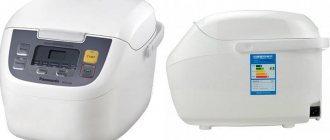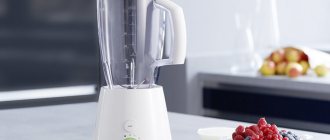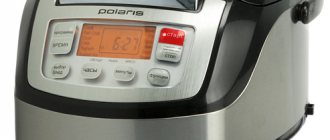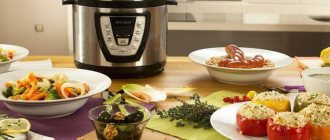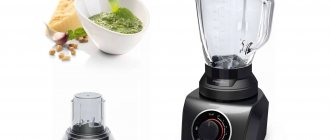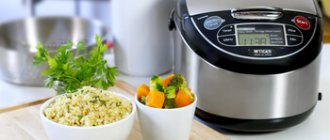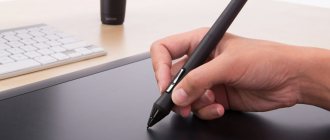Today, multicookers are used in almost every kitchen. A wide range of products on the market makes you think about which multicooker bowl is best. Among the most popular multicooker bowls, it is worth noting the following devices:
- with Teflon coating;
- with ceramic coating;
- bowls without coating.
Let's look at each material in more detail to find out which coating to choose for the multicooker bowl.
Types of coating for multicooker bowls
Teflon coating of the multicooker
Today, the Teflon coating of the multicooker bowl is considered the most popular. The material is old, proven and has unique non-stick properties. The main advantage of this coating is its high strength and complete chemical passivity to aggressive environments.
The most important advantages of Teflon are:
- Heat resistance - the ability of the coating to maintain temperatures up to 260 degrees. Considering that during cooking and frying the temperature rises to a maximum of 100 and 190 degrees, respectively, this is an excellent parameter.
- Teflon-coated bowls are very easy to care for; nothing sticks or burns to them, and due to their high resistance to chemicals, they can be washed with any available detergent. This bowl can also be cleaned in the dishwasher.
- High non-stick properties allow you to cook dishes using a minimum of oil. This is very helpful in preparing diet food.
- Due to its high durability, the coating does not deteriorate over the years, unless mechanical damage is taken into account.
Among the disadvantages of Teflon, it is worth noting that it is plastic, which means it can be scratched or chipped very easily. Naturally, there are models on the market with Teflon coating, which can withstand deliberate scratching by metal objects. But the cost of such multicookers is much higher.
There is a myth that when heated above 260 degrees, Teflon begins to release toxic substances. This is not true, since Teflon is applied at a temperature of 400 degrees, and the declared toxic substance disintegrates at 260.
Teflon coating of the bowl
What is the difference between multicooker bowls?
Bowls vary in volume: popular options are 3 liters (suitable for a family of 2-3 people) and 5 liters (for a large company) . Most are round in shape, but there are also oval models. The coating can be non-stick, ceramic, or Teflon.
Some manufacturers make unlined containers from environmentally friendly materials such as steel and food-grade aluminum . Such models are also called eco-bowls, since these metals do not release harmful substances into the air when preparing dishes. The container is not damaged by cutlery, so it is easy to mix food in it and you can even use a mixer.
Interesting things on the site:
Choosing between an air fryer or a slow cooker
Which is better to choose: a double boiler or a multicooker?
What to look for when choosing a multicooker
Made of ceramics
Which multicooker bowl is better: ceramic or non-stick? Housewives love ceramics for cooking at home and chefs for creating dishes in restaurants. This is a universal material for daily use .
Advantages and disadvantages
Ceramic coating is environmentally friendly and safe for health .
It is suitable for those who suffer from allergies or simply prefer products containing o. When heated, the material does not release toxic substances into the air and can withstand temperatures up to +450°C. It is distinguished by non-stick properties: in such a bowl it is easy to prepare delicious pancakes that will not burn to the surface.
The disadvantage of the material is its high cost . Such models cost several times more than Teflon ones. They cannot withstand extreme temperature changes and are not dishwasher safe.
Do not use aggressive detergents to care for them, otherwise the coating will quickly deteriorate and lose its non-stick properties.
Ceramic coating of the multicooker
Ceramic products are widely used in the kitchen. This is a well-known material that is used to produce high-quality kitchen utensils. Ceramics are heat-resistant and can withstand temperatures up to 450 degrees. But as mentioned earlier, this is an absolutely unimportant parameter, since the multicooker itself heats up by no more than 200 degrees.
Low-quality ceramics, which are provided in budget models of multicookers, have a very short service life - about a year. If you choose a multicooker bowl with a ceramic coating, do not waste money on an expensive multicooker - such a household appliance will serve you for many years.
Among the disadvantages, it is worth noting the low protection from the effects of detergents. The protective coating of ceramics is quickly destroyed when exposed to aggressive chemical elements. It is also worth considering that ceramics is an expensive material, and even budget models have a high price.
Ceramic bowl coating
Types of coatings
The modern market of household appliances is replete with a variety of model lines of multicookers with non-stick coating. Most buyers, as a rule, evaluate the material of the “base” of the body of a household gadget itself, choosing between a metal or plastic structure. Few potential owners of an advanced device are aware or pay due attention when analyzing the available range to the material of the directly functional bowl of the “automated assistant”. But in vain, because it is this indicator that has a huge impact on the quality of food prepared in the appliance, the safety of the resulting dish for human health, the likely durability of the multicooker and the ease of washing it after the “cooking” process is complete.
The most popular today, due to the optimal price-quality ratio for both the buyer and the manufacturer, are Teflon and ceramic bowls. Both Teflon and ceramics cannot be called ideal options for coating the functional element of a multicooker. To formulate your own assessment of the importance of the negative aspects of each type compared to the positive ones, we propose to consider in detail the features of each of them.
First of all, it is worth emphasizing the relative novelty of the idea of using ceramics as a coating for the bowl of the household appliances in question (no more than 8-10 years), despite knowledge about the properties of this material back in the 40s of the last century.
The main advantage of a ceramic multicooker bowl is its environmental friendliness. In an age of poor ecology and widespread use of genetically modified products, the manufacturer’s statement about the absolute safety of the proposed product certainly deserves the attention of consumers. The ecological “purity” of ceramics is achieved due to its water-based production, which makes it possible to exclude harmful impurities contained in the “production” material of the body and functional container from entering the prepared dishes even at high temperatures, as well as imparting a “chemical aroma” to the products.
An equally important positive characteristic of a ceramic coating is its ease of care compared to its Teflon counterpart. So, after finishing cooking, it will be enough to rinse the bowl with detergent and a soft sponge without first “soaking”.
The next distinctive feature of this type of multicooker coating, which characterizes it from the best side, should be called heat resistance. Withstanding temperatures up to 450 degrees Celsius without deformation, the ceramic bowl can easily be used in the hottest oven.
Also, being the base material in the manufacture of a functional multicooker container, ceramics will provide such a gadget with the best non-stick properties. It is worth emphasizing their importance for organizing a comfortable cooking process, especially healthy food or dishes for young children.
However, the ceramic coating of the bowl of a multifunctional gadget, which seems ideal at first glance, has a number of disadvantages, which are important in forming an objective assessment of its quality.
Thus, among the main negative aspects of using devices made from the material in question is low wear resistance. Despite the use of special production technologies by manufacturers that can “extend the life” of ceramics, with regular use of such a gadget, the need to replace the functional bowl will arise approximately 1.5 - 2 years after purchase.
Ceramic coating should be protected from contact with alkali, as a result of which its destruction can occur literally before your eyes in a matter of minutes. This feature will cause significant inconvenience to users who are accustomed to using dishwashers. In such a situation, the owner of a ceramic multicooker will have to carefully select detergents, each time making sure that there is no alkaline element in their composition.
Considering the significant advantages of ceramics listed above, it would not be surprising to see the high cost of multicookers with such a bowl, which can also be attributed to the features of the device in question that do not bring the most pleasant emotions from its use.
Analyzing the Teflon coating, it is worth noting, first of all, among its advantages, high-quality non-stick characteristics, which are significantly superior in their degree to the similar properties of a ceramic coating.
If, when using a ceramic bowl, the owner of a multicooker is forced to carefully select detergents, then a Teflon container is “unpretentious” in care. It is highly resistant to chemical attack and, accordingly, can be “rinsed” without problems after “cooking” even in the dishwasher.
The relatively good heat resistance also deserves special attention and mention among the positive characteristics of the Teflon bowl of a household gadget. It can withstand heating up to 260 degrees without deformation. This temperature is lower than the maximum similar possibility of a ceramic coating, but objectively higher than that of a traditional frying pan or saucepan.
Among the disadvantages of Teflon coating, it is worth highlighting, first of all, its ability to release harmful chemicals when the temperature is “pumped” above the maximum specified. Although this property is quite rare in practice, the mere awareness of such a possibility will certainly bring a lot of negative thoughts and worries to the owner of a multicooker with a functional element made from the material in question.
An equally important feature of the far from positive color is the instability of Teflon to the slightest mechanical damage. A primitive, careless touch of such a coating with a spoon or metal spatula will most likely result in scratches on it, affecting the further functional properties of the multicooker as a whole.
Bowls without coating
On the market you can find a wide range of multicookers without coating. Such devices can be scratched by iron kitchen utensils without any harm to the bowl itself. There are two types of such bowls:
- aluminum;
- made of stainless steel.
They are environmentally friendly, strong and durable, and the simplicity of their manufacture allows them to be very cheap . The only drawback of uncoated utensils is the frequent sticking and burning of food to the bottom and walls of the bowl. The differences between aluminum and stainless steel bowls are due to the properties of the materials from which they are made: aluminum has increased thermal conductivity (4 times more than steel), and steel is stronger and heavier.
High quality stainless steel bowl
How to choose a bowl for a multicooker
4 liter bowl
When selecting a bowl, you should first read the instructions for the equipment, which indicate the parameters of the bowl and the device. Based on the specified characteristics, find an offer on the market or contact the supplier of the model you are using.
If you buy accessories for multicookers in a regular store, you must follow the instructions:
- Measure the height and diameter of the bowl.
- Pay attention to design features (fastening, bottom, presence of handles).
When searching, you can use the manufacturer’s official website, where the parameters of the accessories for each model are described in detail.
The volume, material, and type of coating are available to the user. It is possible to offer similar elements from other models.
Which coating is better to choose?
How to choose the right product material? The Teflon coating is universal and durable (if you use the multicooker carefully and do not scratch it). Such multicookers are cheaper than ceramic ones and are resistant to all kinds of aggressive environments. It is easy to maintain, clean and is dishwasher safe. Ceramic coating is more expensive and requires less maintenance. But if you need a reliable and highly environmentally friendly device, a ceramic multicooker is your choice.
On the multicooker market you can also find devices without coating - steel bowls and stainless steel bowls. They are cheap, highly durable and low maintenance. This bowl can also be used as a regular saucepan. Deciding which coating is better is based on the budget and purpose of using the unit.
You may be interested in: rating of the best multicookers of 2021 based on customer reviews.
https://youtu.be/4h5zimkA7so
Which is better to choose: ceramics or Teflon?
At this point, the best choice would be a ceramic coating. Harmful substances from this material are released at temperatures above 260°C, to which a standard multicooker simply does not heat up. Well, if you clean it carefully and take out food not with a knife, but with a wooden spatula, then such a bowl will serve you for a very long time. As a last resort, you can simply throw out the scratched bowl and buy a new one instead; fortunately, they are much cheaper than ceramics. Well, if you want to try something new, and you have the necessary funds, then you can safely buy a ceramic bowl, and then share your experience of using it in the comments.
